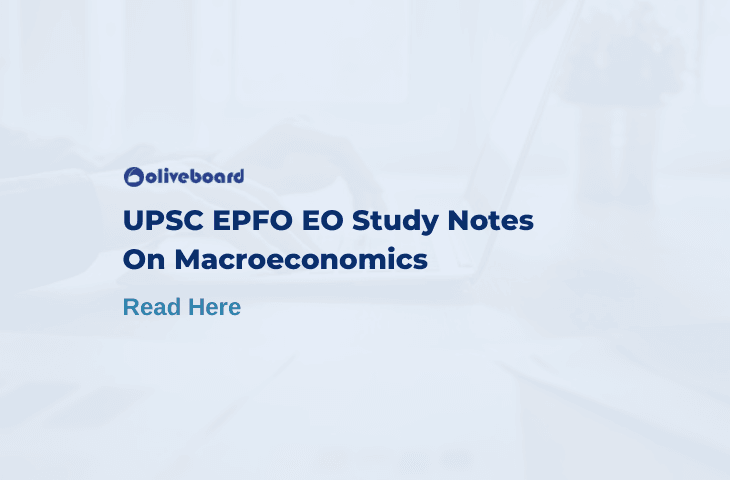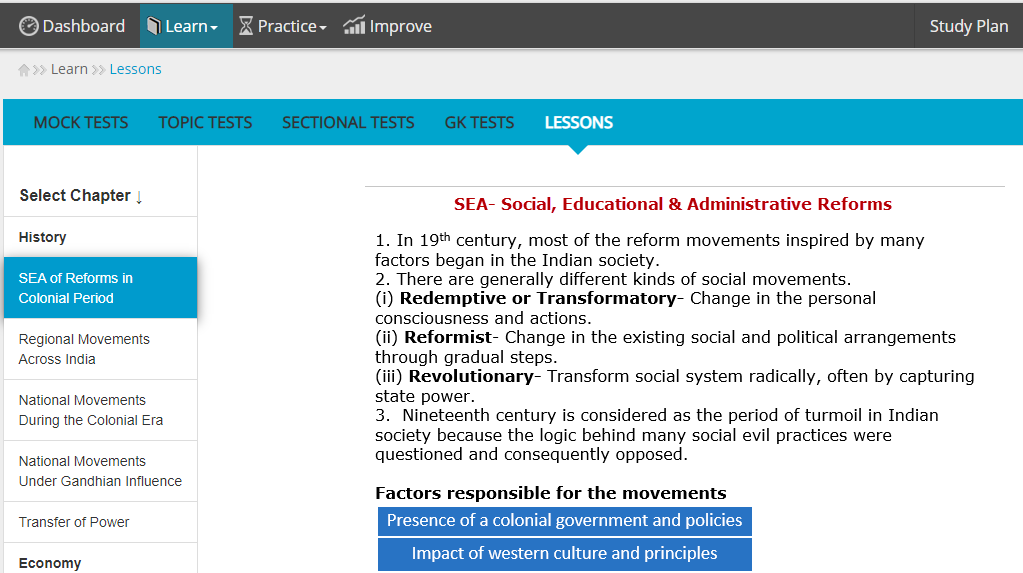While preparing for the UPSC EPFO Enforcement officer exam, one has to cover a wide variety of subjects before being fully prepared for the exam. Economics is one such subject. In this article, we will be providing you with macroeconomics study notes thus preparing your basic concepts. This topic is popularly asked in the exam and the questions from this topic could be easily answered if one is aware of the topic and has gone through it.
Register Now & Start Preparing for UPSC EPFO EO With A Free Mock Test
Let’s start with the article study macroeconomics in-depth:
1. Concept of Macroeconomics Study Notes – UPSC EPFO EO
1.1 What is Macroeconomics?
Macroeconomics is a branch of economics dealing with the performance, structure, behavior, and decision-making of an economy as a whole. This includes regional, national, and global economies.
In macroeconomics, we usually simplify the analysis of how the country’s total production and the level of employment are related to attributes (called ‘variables’) like prices, rate of interest, wage rates, profits and so on, by focusing on a single imaginary commodity and what happens to it.
Macroeconomics and microeconomics are the pairing terms that were coined by Ragnar Frisch.
India is ranked in the top 10 economies of the world. Indian Economy’s GDP is pledged at $2.9 trillion. India’s GDP per capita reached 2,041.091USD in Mar 2019, compared with the 2018 GDP. The GDP per capita income is equivalent to 16% of the world’s average and averaged $693.96 from 1960 until 2017.
Toppers Took the Mock Test & Scored 104/120! Can You Beat The Score? Try Now
2. How did Macroeconomics Emerge?
Macroeconomics emerged as a separate branch of economics after the British economist John Maynard Keynes published his famous book The General Theory of Employment, Interest, and Money in 1936.
There was widespread thinking before Keynes published his book that every worker willing to work will find work and factories will be running at full capacity. This period was known as the Classical Tradition.
Keynes’s book was an attempt to counter the great depression of 1929. This event made them worried about the functioning of the economy. Unlike his predecessors, his approach was to examine the working of the economy in its entirety and examine the interdependence of the different sectors.
2.1 Few Basic Concepts of Macroeconomics:
2.1.1 Income & Output
This forms one of the most basic concepts of macroeconomics. It refers to the total amount of goods produced in a particular country in a specified timeline.
In macroeconomics, economists usually measure national income or output by gross domestic product or GDP. By measuring GDP, economists can understand the market swings and changes. Based on the situations they identify what measures they need to take to improve the GDP of the country.
2.1.2 Unemployment
The next important factor that comes is the unemployment rate. Economists measure the unemployment rate by calculating the no. of individuals who are without jobs. Unemployment categories include classic unemployment, frictional unemployment, and structural unemployment.
When the situations do not allow the institutions to hire more workers it results in large unemployment. This is further classified into 2 unemployment called frictional and Structural.
Frictional unemployment occurs when companies take too long to hire someone appropriate for the job. While Structural unemployment occurs when there is a mismatch between the worker’s skill and the job requirement for the position open.
2.1.3 Inflation & Deflation
Inflation is a sustained increase in the general price level of goods and services in an economy over a period of time. When the general price level rises, each unit of currency buys fewer goods and services; consequently, inflation reflects a reduction in the purchasing power per unit of money – a loss of real value in the medium of exchange and unit of account within the economy.
The opposite of inflation is deflation, a sustained decrease in the general price level of goods and services. Deflation occurs when the inflation rate falls below 0% (a negative inflation rate). Inflation reduces the value of currency over time, but sudden deflation increases it. This allows more goods and services to be bought than before with the same amount of currency. Deflation is distinct from disinflation, a slow-down in the inflation rate, i.e. when inflation declines to a lower rate but is still positive. Source:- Wikipedia
3. Public vs Private Sector Enterprises – Macroeconomics Study Notes
The basic objective of the public sector is to serve the citizens of the country while that of a private enterprise is to earn a profit.
The section of a nation’s economy, which is under the control of the government, whether it is a central, state or local, is known as the Public Sector & the section of a nation’s economy, which is owned and controlled by the private individual’s companies is known as the private sector.
3.1 Economic Indicators
Macroeconomists study aggregated indicators such as GDP, unemployment rates, and price indices to understand how the whole economy functions and develop models that explain the relationship between factors such as national income, output, consumption, unemployment, inflation, saving, government spendings, and international trade.
These variables combine as a whole are referred to as the Economic indicators. These indicators are classified as leading, lagging and coincident relative to their predictive capability, in combination with one another, provide economists with a directional attribution for the economy.
Register Now & take Free Mock test To Assess Your preparations
3.2 Consumer Goods
Consumer goods are the goods that are made available for the final consumption of the consumers. These are also called as the final goods.
These goods are divided into 2 categories – durable and non-durable goods.
Durable goods have an extended product life and are not worn out or consumed quickly when you use them. Durable goods are comparatively more expensive than non-durable goods which are to be purchased again & again.
Indian consumer durable market is broadly classified into two categories urban and rural markets. The sector comprises of the huge middle class and relatively large affluent class. Also, a small economically disadvantaged class is a part of this community.
3.3 Intermediate Goods
These are the products that we use to create another product. In other words, they are inputs in other products or the ingredients of finished goods.
Suppliers of intermediate goods sell them to manufacturers for the inclusion of their final products. Intermediate goods also referred to as the producer goods or semi-finished goods. During the production process, an intermediate good may become part of a finished product. Alternatively, it may change beyond recognition in the process.
Get Study Notes On Social Security & History Now! Click Here
4. Sectors of Indian Economy
4.1 Household Sector
The household sector includes the entire population of society. It includes all of the consumption-seeking members of society, the entire population. In this sector, all the needs related to eating, breathing, fulfilling daily needs are covered.
4.2 Government Sector
This sector includes all government entities that impose resource allocation decisions, that might not be made otherwise, on the rest of the economy. It consists of the three primary levels of federal, state, and local governments responsible for passing and enforcing laws.
Government spending can be financed by government borrowing or taxes. Changes in government spending is a significant component of fiscal policy used to stabilize the macroeconomic business cycle.
Get Complete Study Notes On Indian Polity Here!
4.3 Business Sector
The Business sector or the service sector is concerned with the intangible aspect of offering services to consumers and businesses. It involves the retail of manufactured goods. Services such as insurance and banking are also included in the business sector.
The service sector has grown due to improved labor productivity and higher disposable income. This sector includes those activities that help in the development of the Household and Government sectors by supporting the production processes.
4.4 Foreign Sector
The foreign sector comes into play when a country is not able to fulfill its requirement between the closed economy. Countries then deal with each other accordingly to satisfy their requirements. Countries need to trade among themselves to strengthen their economy.
If one country is a produces of some goods that is present in the abundant amount then it trades with other countries fulfilling their needs and in exchange, they are provided with something that other countries excel in.
This round business cycle flow helps the economy running and blooming.
5. UPSC EPFO Enforcement Officer – Study Materials
Oliveboard has consistently worked on providing the best in class study materials and mock tests to help our students crack the exam. For UPSC EPFO EO also we have brought complete notes to help you prepare for the exam to be conducted on 4th October.
Here is a glimpse of the study notes for the sections that are to come in the examination.
Get Complete Study Notes For UPSC EPFO EO Here
That brings us to the end of this article. We hope that the Macroeconomics study Notes provided here proves useful to your preparations. Now you can get complete study notes for the preparations of the enforcement officer exam on Oliveboard along with the Mock Tests that are specially designed for the UPSC EPFO, keeping in mind the pattern and difficulty level.
You can click on the image below to know all about the Mock Tests and the study notes.
Also, Check:
- 100+ Free Mock Tests
- Oliveboard Mobile App
- Oliveboard’s discuss forum
- Oliveboard Telegram Group
- Download BOLT – Our Monthly General Awareness free e-book

Hello there! I’m a dedicated Government Job aspirant turned passionate writer & content marketer. My blogs are a one-stop destination for accurate and comprehensive information on exams like Regulatory Bodies, Banking, SSC, State PSCs, and more. I’m on a mission to provide you with all the details you need, conveniently in one place. When I’m not writing and marketing, you’ll find me happily experimenting in the kitchen, cooking up delightful treats. Join me on this journey of knowledge and flavors!


